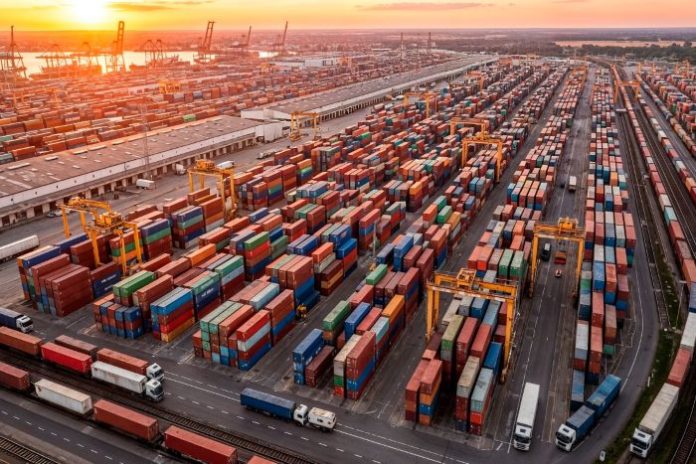The question how to become a distributor often conjures images of warehouses, trucking fleets, and piles of inventory. But in 2025, distribution can be launched and scaled with technology as your infrastructure, not real estate. If your strategy leans on digital tools, automation, tech-first strategies, and smart systems, you can outpace competitors who rely on brute assets.
In this article we packed up the critical tech stack startup distributors need, how to adopt it from day one, and how SimplyDepo fits into that architecture as your practical operational backbone.
Table of contents
Why Tech Is the Heart of Modern Distribution (and “How to Become a Distributor” Means Choosing Tools)
You can’t truly compete in distribution today by doing things on paper, Excel, or manual processes. Distributors that adopt integrated digital systems consistently outperform those relying on legacy tools.
The Competitive Gap Widens Without Specialized Software
Generic tools—accounting software, spreadsheets, standalone CRMs—lack features that distributors require (lot tracking, dynamic routing, supplier order aggregation). Over time that leads to errors, delays, and margin erosion.
Key Functions You Must Automate
- Order-to-cash workflows (order entry, validation, invoicing)
- Inventory management & replenishment (real-time stock levels, safety stock rules)
- Route planning / field execution (optimize rep visits, minimize travel cost)
- Analytics and dashboards (visibility into rep performance, SKU profitability)
- Integrations (ERP/financial system, shipping carriers, supplier systems)
Distributors that adopt purpose-built systems with tech-first strategies gain real-time visibility, reduce friction in field operations, and unlock scalable growth.
Thus, when exploring how to become a distributor, one of the first decisions is which technology stack you will trust as your operational core.
Must-Have Tech Tools for a Lean Distribution Startup
Below is the essential stack for any distributor serious about growth without bloated overhead:
1. Order Management System (OMS)
Automates order capture, pricing, discounts, approvals, and fulfillment handoff. It reduces errors and speeds cycle time from order to shipment.
2. Inventory & Replenishment Engine
Needs to support multi-location inventory, automatic reorder points, lead time awareness, and stock transfers. Advanced systems also support forecasting and safety buffers.
3. Field / Mobile Sales App
Your reps should be able to place orders, check customer history, view catalogs, and track tasks—even offline (for remote regions). The system should sync when connectivity returns.
4. Route Optimization / Field Execution Module
This optimizes daily routes, clusters accounts geographically, and assigns visits to reps for maximum efficiency.
5. Analytics & Dashboard Layer
Real-time dashboards with tech-first strategies that show KPIs like order velocity, fulfillment rates, rep activity, and territory performance.
6. Integration & API Layer
Your distribution tech must connect to accounting/ERP, shipping/carriers (FedEx, UPS, local couriers), supplier portals, e-commerce channels, and CRM. Without this, data becomes siloed.
7. Warehouse / 3PL Connectivity
Even if you outsource storage, your system should integrate with 3PL or warehouse management systems (WMS) for real-time movements.
8. Security, Permissions & Audit Trails
As you scale, you need roles, audit logs, and access controls to maintain data integrity and compliance.
If you architect your business with these tools from the start, you can scale efficiently, minimize headcount, and keep overhead low.
Why SimplyDepo Belongs at Your Core Tech Stack
When you commit to a tech-centric distribution path, you need a system that isn’t a patchwork—something built for your needs. That’s where SimplyDepo adds real, tangible value and tech-first strategies.
What SimplyDepo Brings to the Table
- Unified Order & Catalog Engine: Reps or customers place orders via a digital catalog; no paper or back-office reentry required.
- Offline Mobile Capability: Reps can work even in areas with poor connectivity; orders sync when back online.
- Routing & Visit Planning: Built-in route optimization helps reps visit more accounts in less time.
- Real-Time Dashboards & Reports: View order flow, fulfillment, rep activity, and territory metrics at a glance.
- Integrations (ERP, QuickBooks, Zapier): Data flows cleanly between financial and operational systems.
- Fast Onboarding & Lean Setup: Distributors often report meaningful ROI within months of deployment.
By adopting SimplyDepo as your operations backbone, you reduce reliance on spreadsheets, avoid custom integrations from scratch, and retain flexibility as you scale. You get the core modules already configured for distribution workflows.
When you build a distribution business, how to become a distributor becomes less about physical assets and more about your ability to execute through tools. SimplyDepo gives you a head start in that.
How to Implement Your Tech Stack — Step by Step
Here’s how to adopt these systems without breaking your budget or overextending your team:
1. Prioritize Core Modules
Begin with order management, inventory, and mobile sales. You can delay more advanced modules (like sophisticated forecasting) until after you establish baseline operations.
2. Migrate Incrementally
Move customers in batches, pilot with a subset of reps or geographies, and catch issues early rather than switching over all at once.
3. Build Integration Routes
Set up connectors between SimplyDepo and your accounting or ERP system, shipping carriers, supplier feeds, and possibly e-commerce channels.
4. Train Field Users First
Your sales reps are your front line—train them early on the mobile app and field workflows so data is clean from day one.
5. Monitor & Iterate
Use dashboards to monitor adoption, error rates, order exceptions, and system gaps. Refine workflows iteratively.
6. Layer in Automation & AI
Over time, add demand forecasting, replenishment automation, and exception workflows to reduce human oversight.
By following this rollout path, you balance speed with reliability, avoid data chaos, and make your system and tech-first strategies your strategic advantage.
Final Thoughts: Tech Converts Strategy into Execution
The phrase how to become a distributor isn’t just about starting relationships or securing product lines—it’s a question of how to execute distribution efficiently, reliably, and at scale.
In 2025, the difference between a hobbyist distributor and a market leader is less about warehouse size and more about software, data, and field discipline. If you build your operation around a modern stack from day one—with tools for ordering, inventory, routing, and analytics—you position yourself for exponential growth rather than painful refactoring.
And with SimplyDepo, you get a ready-made, distribution-centric platform and tech-first strategies that accelerates your launch, reduces integration overhead, and gives your lean operation the muscle it needs to grow.











